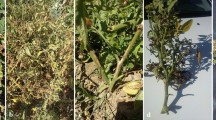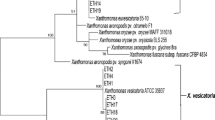Abstract
Tomato is the most produced and consumed vegetable in Turkey, and has a great importance in farmers’ income. In this study, bacterial disease surveys were carried out in 130 plastic covered greenhouses in the center and eight district neighborhoods of Mersin province, Turkey from January to May, 2019 and 2020 growing periods, respectively. Suspicious tomato plants showing typical disease symptoms such as stem rot, pith necrosis and secondary root formation on the stem were collected from twelve different greenhouses. The representative bacterial strains (n = 20) were initially characterized based on pathogenicity test on tomato seedlings, phenotypic characteristics, and then identified as Stenotrophomonas spp., and Paenibacillus spp. according to their protein fingerprint patterns obtained by MALDI TOF MS system. The identification of three strains was further confirmed by sequencing of 16 S rDNA. According to BLAST analysis, the strains shared 99–100% identity with Stenotrophomonas rhizophila, Stenotrophomonas chelatiphaga and Paenibacillus amylolyticus strains deposited in GenBank. The prevalences of tomato inner pith necrosis and stem rot caused by Paenibacillus amylolyticus and Paenibacillus polymxa and pith necrosis caused by Stenotrophomonas spp. were 0.8% and 4.6%, respectively in the area. Representative bacterial strains were further tested for copper sensitivity in vitro, and, all strains were resistant for 1 mM copper amended KB media. This study represented the first report of newly introduced stem and core rot and pith necrosis caused by Paenibacillus amylolyticus, Paenibacillus polymxa and Stenotrophomonas spp., on tomato in Turkey.




Similar content being viewed by others
References
Ash C, Priest FG, Collins MD (1993) Molecular identification of rRNA group 3 bacilli (Ash, Farrow, Wallbanks and Collins) using a PCR probe test. Proposal for the creation of a new genus Paenibacillus. Antonie Van Leeuwenhoek 64:253–260. https://doi.org/10.1007/BF00873085
Aysan Y, Çınar Ö, Nabizadeh-Ardekani F, Rudolph K (1999) Identification of Pseudomonas syringae Pv. Tomato (PST) on tomatoes by ELISA and PCR, and determination of races of PST in Turkey. J Turkish Phytopathol 28:45–54
Aysan Y, Sahin F, Cetinkaya-Yildiz R, Mirik M, Yucel Y (2005) Occurrence and primer inoculum sources of bacterial stem rot caused by Erwinia species on tomato in the eastern Mediterranean region of Turkey. J Plant Dis Prot 112:42–51. http://www.jstor.org/stable/43215622
Chalupová J, Raus M, Sedlářová M, Šebela M (2014) Identification of fungal microorganisms by MALDI-TOF mass spectrometry. Biotechnol Adv 32:230–241. https://doi.org/10.1016/j.biotechadv.2013.11.002
Chetelat RT (2014) Tomato Diseases, pests and disorders. In: Jones JB, Zitter TA, Momol TM, Miller S (eds) (Eds:) Compendium of tomato Diseases and pests, 2nd edn. APS Press, Minnesota, pp 1–5
Coskun TA, Horuz S (2023) Phosphites for the management of tomato bacterial canker and stem rot. J Plant Dis Prot 130:609–617. https://doi.org/10.1007/s41348-023-00725-9
Eğerci K, Özaktan H, Eğerci Y (2021) Studies on the sensitivity level of some plant pathogenic and saprophytic bacteria against copper based compounds. J Turk Phytopath 50(1):1–7
FAO (2021) Crops and livestock products https://www.fao.org/faostat/en/#data/QCL Accessed 5 April 2023
Frank JA, Reich CI, Sharma S, Weisbaum JS, Wilson BA, Olsen GJ (2008) Critical evaluation of two primers commonly used for amplification of bacterial 16S rRNA genes. Appl Environ Microbiol 74:2461–2470. https://doi.org/10.1128/AEM.02272-07
Gessler C, Pertot I, Perazzolli M (2011) Plasmopara Viticola: a review of knowledge on downy mildew of grapevine and effective Disease management. Phytopathol Mediterr 50:3–44. https://www.jstor.org/stable/26458675
Haji Nour SM, Horuz S (2023) Determination of the efficacies of different phosphites in the management of tomato bacterial speck Disease caused by Pseudomonas syringae Pv. Tomato. Mustafa Kemal University J Agricultural Sciences 28(1):25–37. https://doi.org/10.37908/mkutbd.1136131
Husseini A, Akköprü A (2020) The possible mechanisms of copper resistance in the pathogen Pseudomonas syringae pathovars in stone fruit trees. Phytoparasitica 49:684–698. https://doi.org/10.1007/s12600-020-00828-1
King EO, Ward MK, Raney DE (1954) Two simple media for the demonstration of pyocianin and flouresin. J Lab Clin Med 44:301–307. https://doi.org/10.5555/uri:pii:002221435490222X
Kudela V, Krejzar V, Pankova I (2010) Pseudomonas corrugata and Pseudomonas marginalis associated with the collapse of tomato plantsin rockwool slab hydroponic culture. Plant Prot Sci 46:1–11. https://doi.org/10.17221/44/2009-PPS
Kumar S, Stecher G, Li M, Knyaz C, Tamura K (2018) MEGA X: Molecular Evolutionary Genetics Analysis across computing platforms. Mol Biol Evol 35:1547–1549. https://doi.org/10.1093/molbev/msy096
Lelliot RA, Stead DE (1987) Methods for the diagnosis of bacterial Diseases of plants. Black Well, Oxford, USA
Mensi I, Jabnoun-Khiareddine H, Zarrougui NE, Zahra H, Cesbron S, Jacques MA, Daami-Remadi M (2018) First report of tomato bacterial speck caused by Pseudomonas syringae Pv. Tomato in Tunisia. New Disease Reports 38:21. https://doi.org/10.5197/j.2044-0588.2018.038.021
Mirik M, Aysan Y, Cinar O (2007) Copper-resistant strains of Xanthomonas axonopodis Pv. Vesicatoria (Doidge) Dye in the Eastern Mediterranean region of Turkey. J Plant Pathol 89:153–154. https://doi.org/10.4454/jpp.v89i1.737
Öztürk M, Soylu S (2022) A new Disease of strawberry, bacterial blight caused by Erwinia amylovora in Turkey. J Plant Pathol 104:269–280. https://doi.org/10.1007/s42161-021-00994-z
Palleroni NJ, Bradbury JF (1993) Stenotrophomonas, a new bacterial genus for Xanthomonas maltophilia (Hugh 1980) swings. Et al. 1983. Int J Syst Bacteriol 43:606–609. https://doi.org/10.1099/00207713-43-3-606
Pavlovic M, Konrad R, Iwobi AN, Sing A, Busch U, Huber I (2012) A dual approach employing MALDI-TOF MS and real-time PCR for fast species identifcation within the Enterobacter cloacae complex. FEMS Microbiol Lett 328:46–53. https://doi.org/10.1111/j.1574-6968.2011.02479.x
Ryan R, Monchy S, Cardinale M, Taghavi S, Crossman L, Avison MB, Berg G, van der Lelie D, Dow JM (2009) The versatility and adaptation of bacteria from the genus Stenotrophomonas. Nat Rev Microbiol 7:514–525. https://doi.org/10.1038/nrmicro2163
Sahin F, Uslu H, Kotan R, Dönmez MF (2002) Bacterial canker, caused by Clavibacter michiganensis ssp. michiganensis, on tomatoes in eastern Anatolia region of Turkey. Plant Pathol 51:399. https://doi.org/10.1046/j.1365-3059.2002.00715.x
Sahin F, Aysan Y, Saygili H (2005) First observation of pith necrosis on tomato caused by some Pseudomonas species in Turkey. Proc 1st Int Symp Tomato Dis Acta Horticulturae 695:93–95. https://doi.org/10.17660/ActaHortic.2005.695.9
Sakiyama CCH, Paula EM, Pereira PC, Borges AC, Silva DO (2001) Characterization of pectin lyase produced by anendophytic strain isolated from coffee cherries. Lett Appl Microbiol 33:117–121. https://doi.org/10.1046/j.1472-765x.2001.00961.x
Serin M, Horuz S (2022) Determination of the prevalence of bacterial Diseases in tomato greenhouses in Silifke district of Mersin province. Mustafa Kemal University J Agricultural Sciences 27(1):79–87. https://doi.org/10.37908/mkutbd.1026011
Sibiya J, Mwashaireni A, Manyangarirwa W, Mguni C, Mortensen C (2003) Incidence and seed-borne status of bacterial pathogens of tomato and paprika in the smallholder-farming sector of Zimbabwe. Afr Crop Sci Conf Proc 6:299–302
Stoyanova M, Bogatzevska N (2012) Stenotrophomonas maltophilia in scabs of tomato fruits. Sci Technol 2:35–38
Stoyanova MI, Ganeva DG, Petrov NM, Bogatzevska NS (2018) Stenotrophomonas maltophilia - an emerging pathogen of local varieties of tomatoes in Bulgaria. Acta Microbiol Bulg 34:180–186
Swings J, Devos P, Vandenmooter M, Deley J (1983) Transfer of Pseudomonas maltophilia Hugh 1981 to the genus Xanthomonas maltophilia (Hugh 1981) comb. Nov. Int J Syst Bacteriol 33:409–413. https://doi.org/10.1099/00207713-33-2-409
Teeraphatpornchai T, Nakajima-Kambe T, Shigeno-Akutsu Y (2003) Isolation and characterization of a bacterium that degrades various polyester-based biodegradable plastics. Biotechnol Lett 25:23–28. https://doi.org/10.1023/A:1021713711160
Tireng Karut Ş, Horuz S, Aysan Y (2019) Detection of tomato bacterial canker and wilt disease agent Clavibacter michiganensis subsp. michiganensis on/in tomato seeds and efficacy of different seed treatments on pathogen development. Journal of Tekirdag Agricultural Faculty 19 (3):284–296. https://doi.org/10.33462/jotaf.526167
TUIK (2022) Turkish Statistical Institute. https://data.tuik.gov.tr/Kategori/GetKategori?p=tarim-111&dil=1medas/?kn=92&locale = tr). Accessed 5 April (2023)
Validov S, Kamilova F, Qi S, Stephan D, Wang JJ, Makarovaand N, Lugtenberg B (2006) Selection of bacteria able to control Fusarium oxysporum f. sp. radicis-lycopersici in stonewool substrate. Journal of Applied Microbiology, 102,461–471. https://doi.org/10.1111/j.1365-2672.2006.03083.x
Weisburg WG, Barns SM, Pelletier DA, Lane DJ (1991) 16S ribosomal DNA amplification for phylogenetic study. J Bacteriol 173:697–703. https://doi.org/10.1128/jb.173.2.697-703.1991
Yang D, Cha S, Choi J, Seot T (2018) Paenibacillus mobilis sp. nov., a gram-stain-negative bacterium isolated from soil. Int J Syst Evol Microbiol 68:1140–1145. https://doi.org/10.1099/ijsem.0.002643
Acknowledgements
This work was performed as part of a Master’s thesis, and the authors thank Erciyes University Scientific Research Projects Coordination Unit for financial support (FYL 2019 9570).
Author information
Authors and Affiliations
Contributions
The author, Sumer Horuz contributed to the supervision process of the research, designing the methodology, planning the study, surveying the greenhouses, making the isolations and identifying the strains, interpreting the data, and writing the initial manuscript. The author Mehmet Serin contributed to surveying the greenhouses, running the tests for identification, and performing the experiments.
Corresponding author
Ethics declarations
Conflict of interest
The authors declare that they have no competing interests.
Additional information
Publisher’s Note
Springer Nature remains neutral with regard to jurisdictional claims in published maps and institutional affiliations.
Rights and permissions
Springer Nature or its licensor (e.g. a society or other partner) holds exclusive rights to this article under a publishing agreement with the author(s) or other rightsholder(s); author self-archiving of the accepted manuscript version of this article is solely governed by the terms of such publishing agreement and applicable law.
About this article
Cite this article
Horuz, S., Serin, M. Occurrence and pathogenicity of Stenotrophomonas spp. and Paenibacillus spp. on tomato plants in Turkey. J Plant Pathol 106, 191–201 (2024). https://doi.org/10.1007/s42161-023-01540-9
Received:
Accepted:
Published:
Issue Date:
DOI: https://doi.org/10.1007/s42161-023-01540-9




